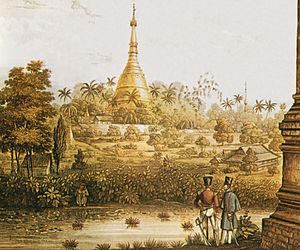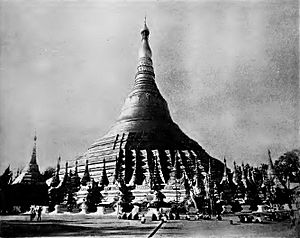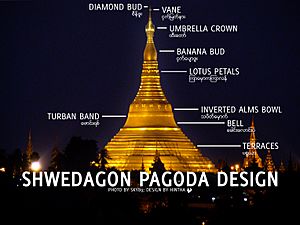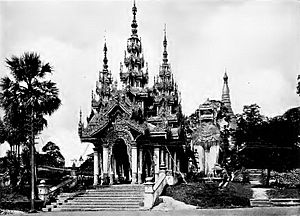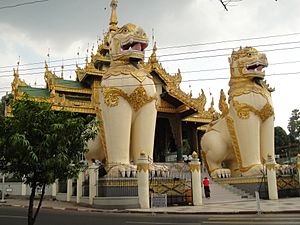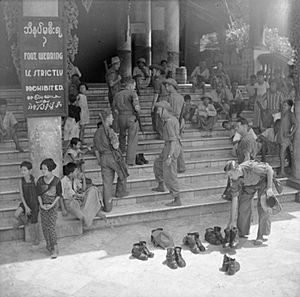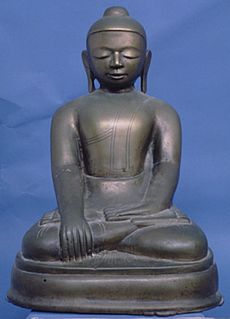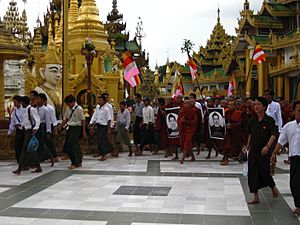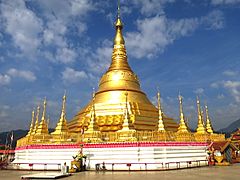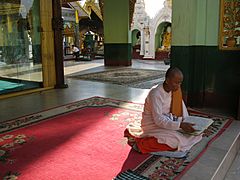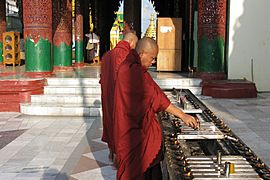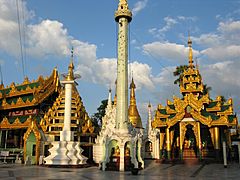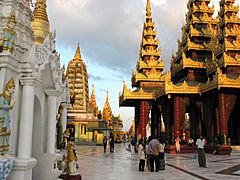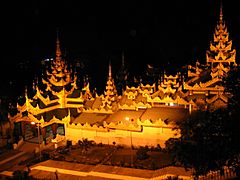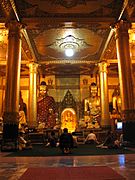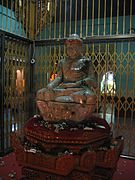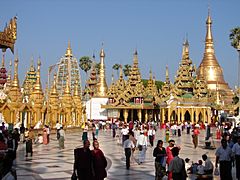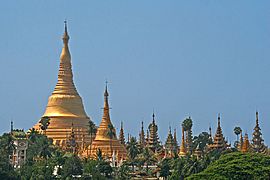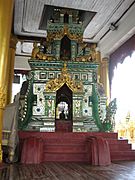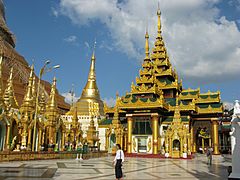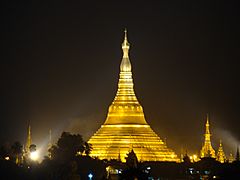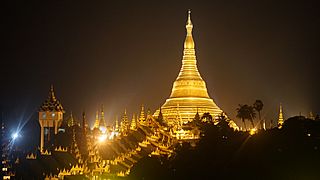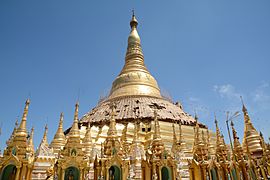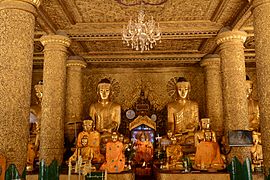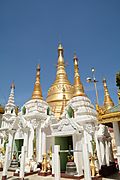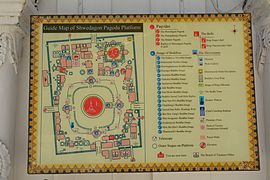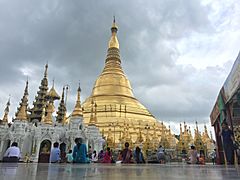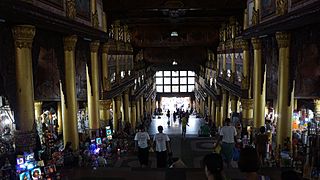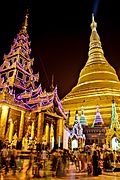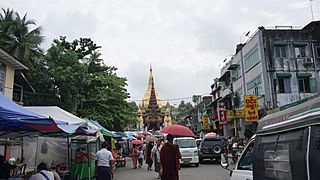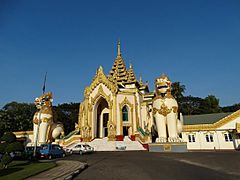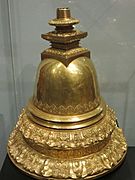Shwedagon Pagoda facts for kids
Quick facts for kids Shwedagon Pagoda |
|
|---|---|
|
ရွှေတိဂုံစေတီတော်
|
|
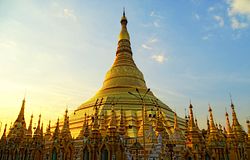 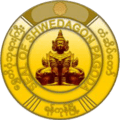 |
|
| Religion | |
| Affiliation | Buddhism |
| Sect | Theravada Buddhism |
| Region | Yangon Region |
| Festival | Shwedagon Pagoda Festival (Tabaung) |
| Governing body | The Board of Trustees of Shwedagon Pagoda |
| Status | Active |
| Location | |
| Municipality | Yangon |
| Country | Myanmar |
| Architecture | |
| Completed | 1362–63 (or earlier) 1462 1775 |
| Specifications | |
| Height (max) | 99 m (325 ft) |
| Spire height | 112 m (367 ft) |
The Shwedagon Pagoda is a famous golden stupa (a dome-shaped building for Buddhist relics) in Yangon, Myanmar. It's also known as the Great Dagon Pagoda or the Golden Pagoda.
This pagoda is the most sacred Buddhist site in Myanmar. People believe it holds special items from four past Buddhas. These include a staff, a water filter, a piece of a robe, and eight strands of hair from Gautama Buddha himself.
The pagoda is built on a hill called Singuttara Hill, which is 51-metre (167 ft) high. The pagoda itself is 112 m (367 ft) tall. It stands 170 metres (560 feet) above sea level, making it a very noticeable landmark in Yangon. City rules keep other buildings lower so the Shwedagon Pagoda always stands out.
Contents
History of the Shwedagon Pagoda
An old story says the Shwedagon Pagoda was built over 2,500 years ago. This would make it the oldest Buddhist stupa in the world. The story tells of two merchants, Tapussa and Bhallika, who met the Buddha. He gave them eight strands of his hair. He also told them how to build a stupa to keep these hairs safe.
The merchants brought the hair to King Okkalapa of Dagon. The King placed the hair, along with relics from three earlier Buddhas, inside a stupa on Singuttara Hill.
The first official records of the pagoda are from 1362/63 CE. King Binnya U made the pagoda taller, reaching 18 m (59 ft). Later, Queen Shin Saw Pu made it even taller, about 40 m (130 ft). She also covered the new structure with gold. By the 1500s, the Shwedagon Pagoda was a very famous place for Buddhist pilgrims.
Over the years, earthquakes damaged the pagoda. The worst one in 1768 knocked off the top. But King Hsinbyushin rebuilt it in 1775 to its current height of 99 m (325 ft). A new crown, called a hti, was added by King Mindon Min in 1871. In 1970, another earthquake caused damage, and it needed big repairs.
The Shwedagon Pagoda Festival is the biggest pagoda festival in Myanmar. It starts during the new moon in the month of Tabaung and lasts until the full moon. The pagoda is also listed as a heritage site in Yangon.
Design of the Pagoda
The bottom part of the stupa is made of bricks covered with gold plates. Above this are terraces that only monks and men can go on. Next is the bell-shaped part. Above that, you'll see a turban-like section, then an upside-down alms bowl, and then lotus petals.
At the very top is the "banana bud" shape, and then the hti (umbrella crown). This crown is decorated with 5,448 diamonds and 2,317 rubies! The very tip, called the diamond bud, has a huge 76-carat diamond.
The gold you see on the stupa is real gold plates. They cover the brick structure and are held on by traditional rivets. People from all over the country, and even past kings and queens like Queen Shin Saw Pu, have given gold to help keep the pagoda beautiful.
There are four entrances, each with steps leading up to the main platform on Singuttara Hill. A pair of giant lion-like creatures called leogryphs guard each entrance. Near the eastern and southern entrances, you can find vendors selling books, good luck charms, Buddha images, candles, gold leaf, and flowers.
It's a tradition to walk around Buddhist stupas in a clockwise direction. You can start at the eastern shrine, which has a statue of Kakusandha, the first Buddha of this age. Then you move to the southern shrine for Koṇāgamana, the second Buddha. The western shrine has Kassapa, the third Buddha, and finally, the northern shrine has Gautama, the fourth Buddha.
Rituals at the Pagoda
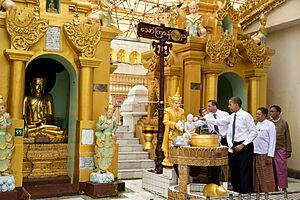
Many Burmese Buddhists follow practices from Hindu astrology. They believe in seven planets, plus two others called Rahu and Ketu. The days of the week are named after these planets. Wednesday is special because it's split into two days: Wednesday until 6 PM, and Rahu's day from 6 PM until midnight.
It's important for Burmese Buddhists to know their birth day of the week. This tells them their "planetary post." There are eight posts because Wednesday is split. Each post has an animal representing the day:
- Sunday: garuda (a mythical bird)
- Monday: Tiger
- Tuesday: Lion
- Wednesday morning: Tusked elephant
- Wednesday afternoon: Tuskless elephant
- Thursday: Mouse
- Friday: Guinea pig
- Saturday: nāga (a mythical snake-like creature)
Each planetary post has a Buddha statue. Visitors offer flowers and flags and pour water on the statue. This is called a Blessing Ritual, and they make a prayer or wish. Below the statue is the animal for that day. The base of the stupa is octagonal and has eight small shrines, one for each planetary post. Many people perform a blessing ritual at their own planetary post.
When pilgrims go up the pagoda steps, they often buy flowers, candles, and flags. These are placed at the stupa as a symbolic act of giving, which is important in Buddhist teachings. There are also donation boxes for voluntary offerings to help maintain the pagoda. In 2017, foreign visitors paid a fee of about US$7 to enter.
Shwedagon in Literature
The famous writer Rudyard Kipling visited the Shwedagon Pagoda in 1889. He described his visit ten years later in his book From Sea to Sea and Other Sketches, Letters of Travel. He wrote about seeing the "golden mystery" that "blazed in the sun," calling it a "beautiful winking wonder." He noted how it made him understand that "This is Burma, and it will be quite unlike any land you know about."
War and Invasion
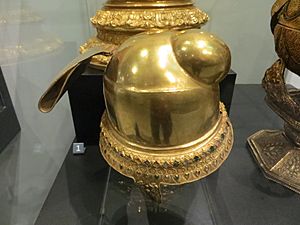
In 1608, a Portuguese adventurer named Filipe de Brito e Nicote tried to steal from the Shwedagon Pagoda. His men took the huge 300-ton Great Bell of Dhammazedi. He wanted to melt it down for cannons, but it fell into the Bago River and has never been found.
Two centuries later, the British arrived in 1824 during the First Anglo-Burmese War. They took over the Shwedagon Pagoda and used it as a fort for two years. There was some looting and damage. The British also tried to take the 23-ton Singu Min Bell, but it also fell into the river. When the British couldn't get it out, the local people offered to help if the bell could be returned to the pagoda. The British agreed, and the people used bamboo poles to float the bell back to the surface. It was then returned to the pagoda.
During the Second Anglo-Burmese War in 1852, the British took control of the Shwedagon again. This time, they kept military control for 77 years, until 1929, though people could still visit. Lord Maung Htaw Lay, an important Burmese leader, worked to stop the British army from taking treasures. He helped restore the pagoda with financial help from the British. He became a founding trustee of the Shwedagon Pagoda Trust.
Political Importance
The Shwedagon Pagoda has been a key place for political events in Myanmar.
- In 1920, university students met at the pagoda to plan a protest strike against a new law. This led to the creation of "national schools" run by the Burmese people. This day is now celebrated as National Day.
- In 1938, oilfield workers on strike camped at the pagoda. This strike was broken up by police, who wore shoes inside the pagoda grounds, which was a big insult to Burmese people.
The "shoe question" has been a sensitive issue since colonial times. Burmese people always removed their shoes at pagodas. But European visitors and soldiers often didn't. In 1902, a monk named U Dhammaloka publicly challenged a police officer for wearing shoes. It wasn't until 1919 that the British finally banned footwear, but they made exceptions for government workers. This rule and its exception angered people and helped start the nationalist movement. Today, no shoes or socks are allowed on the pagoda.
- In 1946, General Aung San spoke at the stupa, demanding independence from the British.
- In 1988, his daughter, Aung San Suu Kyi, spoke to 500,000 people at the stupa. She called for democracy from the military government.
September 2007 Protests
In September 2007, there were big protests against the military government. Monks were first blocked from the pagoda but later allowed in. On September 24, 2007, 20,000 monks and nuns marched at the Shwedagon Pagoda. The next day, 30,000 people, led by monks, marched past Aung San Suu Kyi's party office.
On September 26, 2007, there were clashes between security forces and protesters. Security forces used tear gas and force to break up peaceful demonstrations by monks around the Shwedagon Pagoda. Monks were arrested and taken away. Soldiers also blocked off monasteries.
Replicas of Shwedagon Pagoda
There are several replicas of the Shwedagon Pagoda around the world:
- Uppatasanti Pagoda in Naypyidaw, Myanmar's capital. It was finished in 2009 and is almost the same height as the original.
- A 46.8 m (154 ft) tall replica in Lumbini Natural Park in Berastagi, North Sumatra, Indonesia. It was completed in 2010, and its building materials came from Myanmar.
- Global Vipassana Pagoda, 29 m (95 ft) high, opened in 2009 in Mumbai, India.
- Tachileik Shwedagon Pagoda near the Golden Triangle in Myanmar.
Gallery
-
Devotees paying homage to the Triple Gem
See also
 In Spanish: Shwedagon para niños
In Spanish: Shwedagon para niños
- Awgatha
- Gadaw
- Shinbyu
- Burmese pagoda
- Pagoda festival
- Buddhism in Burma
- History of Buddhism
- List of tallest structures built before the 20th century



